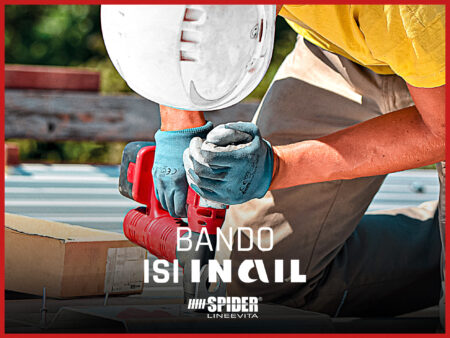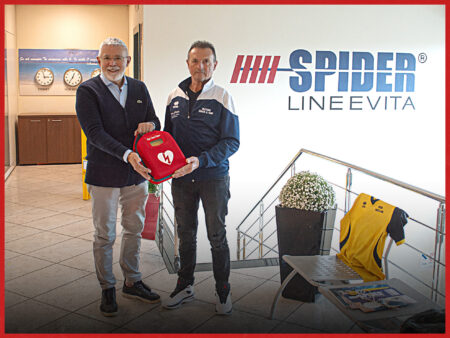Lifelines are one of the simplest and safest solutions to protect your roof. It is a series of steel rails connected to each other and to structural elements that create an anchoring system to which small ropes are fixed.
Lifelines are used to ensure the safety of workers operating on a roof. They are designed to ensure that there is no risk of accidental fall or accident in the event of a fall. In addition, they also allow greater comfort during maintenance or construction of the roof.
In this article we will look at the different types of roofs and the risks associated with them, how to install lifelines on different types of roofs, and what else you should know before venturing into the world of worker safety at height.
What types of roofs are there?
There are different types of roofs according to their functions, the materials used and durability.
To better classify the types of roof, these categories must be considered:
Main problems, risks and solutions related to a roof not protected by a lifeline
Protecting a roof with lifelines is essential to limit the risks of accidents or injuries concerning workers, but also visitors. The main problems, risks and solutions associated with a roof not protected by Linee Vita are:
Risk of falling from heights
Any roof that has a slope greater than 70° and heights greater than 2 meters represents a source of risk, as most fire safety devices may not be sufficient. The prevention of this type of accident is possible through the installation of lifelines that can guarantee the safety of individuals at high heights.
Distraction injury
A common cause of roof injury is distraction. Due to the lack of protection provided by Lifelines, people who are working or visiting the roof are more susceptible to accidents resulting from distraction that can be caused by multiple reasons such as alarming footage or slippery pavements.
The Regulations
Device of art. 148 TUSL
Sources → Consolidated Law on Safety at Work → Title IV – Temporary or mobile construction sites → Chapter II – Rules for the prevention of accidents at work in construction and work at height → Section VII – Building constructions
The extract of the TUSL ( Legislative Decree 81/2008 consolidated text on safety at work) determines a first regulatory framework for work on roof, in which the concept of priority of collective measures over individual ones is reiterated.
Further normative references in this regard can be found in the technical standards:
UNI 11560:2022 Permanent anchoring systems on the roof – Guide for the identification, configuration, installation, use and maintenance.
Why do I need to install a roofline system?
Lifelines ensure that the strength of materials is visible and well distributed along the spaces between the parts with which they are built.
In particular, lifelines are indispensable in strong winds and storms, as they ensure that the roof does not yield to strong gusts of wind. In addition, their installation reduces the risk of detachment or injury caused by free fall.
Another concern related to the maintenance of the safety of the roof is that related to the type and quality of the materials used in its construction: if the materials are inadequate or not well worked, problems such as breakage or sudden detachment of the parts due to very strong wind loads can occur. To avoid this situation, it is better to prevent than to cure and install an adequate system of lifelines on the surface of the roof.
The most common types of roof in Italy? those with pitch
In Italy, the most common types of roof are pitched roofs. This type of roofing is characterized by two inclined surfaces that meet in the center of the roof, forming an acute angle. The slope of the pitches may vary depending on the architecture of the building and the climatic conditions of the area in which it is located.
Not all products are suitable for every type of roof, and the wrong choice could cause problems such as water infiltration, damage to the structure or thermal insulation problems.
Among the most common types of pitched roofs in Italy are the gable roof, the four-pitched roof and the hipped roof. The gable roof is the simplest and most traditional, with the two inclined surfaces meeting in the center of the roof. The four-pitched roof has four inclined surfaces that converge towards a central point, creating a pyramidal shape. The hipped roof instead has two pitches that meet at right angles, creating an L-shape.
In addition to pitched roofs, there are also other types of roofs used in Italy, such as flat roofs or terraces and curved roofs. Flat roofs are widely used in urban areas to create outdoor spaces that can be used as terraces or hanging gardens. Curved roofs, on the other hand, are less common but can be used to create a particular architectural effect.
In any case, the choice of the type of roof depends on the aesthetic and functional needs of the building and the context in which it is located. It is important to carefully evaluate the characteristics of the roof before proceeding with its construction or replacement, to ensure maximum safety and durability.
How do I install roof lifelines?
Thanks to the installation of lifelines on the roof, it is possible to drastically reduce the risks associated with the fall of the person, especially in the case of maintenance or installation of photovoltaic panels. But how exactly do you install lifelines on a roof?
Lifelines are generally formed by a metal structure consisting of interlocking rails and brackets, made of galvanized or stainless steel profiles. Profiles must be properly anchored to the load-bearing structural elements of the roof, for example, reinforced concrete beams and pillars. The structure must be designed to fit the size and slope of the roof and it is important to ensure that the elements are fixed to the supporting structure with suitable fixings.
Another important element in the installation of lifelines is to ensure that they comply with current safety regulations. Before installation, the company in charge must verify compliance with all the parameters relating to the maximum load required by current legislation
Degree of accessibility: roofs accessible only for maintenance or livable
In the field of coverage, different types can be distinguished according to the degree of accessibility they offer. In particular, it is possible to identify roofs that can only be used for maintenance and livable roofs.
The roofs accessible only for maintenance are those that do not allow continuous use by the inhabitants of the house. These are therefore covers that have a purely technical function, namely to allow access to professionals to carry out maintenance and repair operations. Typically, these roofs are characterized by a high slope, which makes them unsuitable for use as habitable spaces.
Livable roofs, on the other hand, are those that offer the possibility of being used as additional living spaces. These roofs have a less pronounced slope than roofs accessible only for maintenance and are equipped with windows or skylights to allow natural light to enter. In some cases, these roofs can also be equipped with terraces or balconies, which further increase their usability.
Among the most used materials for the construction of livable roofs we find wood, metal and reinforced concrete. Each material has different characteristics and performances in terms of thermal and acoustic insulation, weather resistance and durability over time. The choice of the most suitable material therefore depends on the specific needs of the house and its inhabitants.
In conclusion, the choice between a roof that can only be used for maintenance and a livable roof depends on the needs of the house and its inhabitants. Both solutions have advantages and disadvantages depending on the use to be made. It is therefore important to carefully evaluate all available options before making the final choice.
 Agevolazioni
Agevolazioni  Events
Events